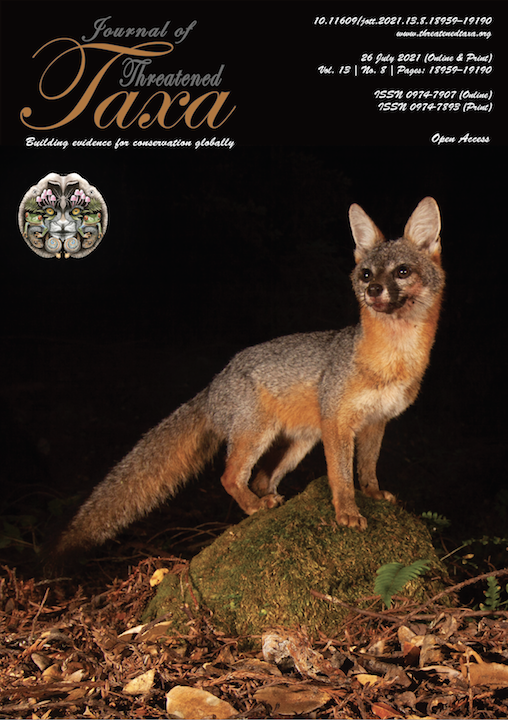Descriptions of the early stages of Vagrans egista sinha (Lepidoptera: Nymphalidae) with notes on its host plant Xylosma longifolia Clos from the western Himalaya of India
Main Article Content
Abstract
Distribution, life history stages, and status of Vagrans egista sinha (Kollar, 1844) in western Himalaya are presented. It is for the first time that this butterfly is reported on Xylosma longifolia Clos from Dehradun, Uttarakhand (India).
Article Details

This work is licensed under a Creative Commons Attribution 4.0 International License.
Authors own the copyright to the articles published in JoTT. This is indicated explicitly in each publication. The authors grant permission to the publisher Wildlife Information Liaison Development (WILD) Society to publish the article in the Journal of Threatened Taxa. The authors recognize WILD as the original publisher, and to sell hard copies of the Journal and article to any buyer. JoTT is registered under the Creative Commons Attribution 4.0 International License (CC BY), which allows authors to retain copyright ownership. Under this license the authors allow anyone to download, cite, use the data, modify, reprint, copy and distribute provided the authors and source of publication are credited through appropriate citations (e.g., Son et al. (2016). Bats (Mammalia: Chiroptera) of the southeastern Truong Son Mountains, Quang Ngai Province, Vietnam. Journal of Threatened Taxa 8(7): 8953–8969. https://doi.org/10.11609/jott.2785.8.7.8953-8969). Users of the data do not require specific permission from the authors or the publisher.
References
Bascombe, M., F. Bascombe & G. Johnston (1999). The Butterflies of Hong Kong. Academic Press, London, 422pp.
Bingham, C.T. (1905). The fauna of British India including Ceylon and Burma — butterflies. Vol I. Taylor and Francis, London, 528pp.
Corbet, A.S. & H.M. Pendlebury (1992). The Butterflies of the Malay Peninsula. 4th edition revised by Eliot, J.N. Malayan Nature Society, Kuala Lumpur.
D’Abrera, B. (1985). Butterflies of the Oriental Region, Part II. Nymphalidae, Satyridae & Amathusidae. Hill House, Melbourne, 534pp.
Evans, W.H. (1932). The Identification of Indian Butterflies—2nd Edition. Bombay Natural History Society, Bombay, 454pp.
Gokhale, P. (2020). Vagrans egista (Cramer, [1780]) – Vagrant. Kunte, K., S. Sondhi, & P. Roy (Chief Editors). Butterflies of India, v. 2.88. Indian Foundation for Butterflies.http://www.ifoundbutterflies.org/sp/908/Vagrans-egista. Electronic version accessed 8 July 2020.
Igarashi, S. & H. Fukuda (1997). The Life Histories of Asian Butterflies. Vol. 1. Tokai University Press, Tokyo, 572pp.
Johnston, G. & B. Johnston (1980). This is Hong Kong: Butterflies. Hong Kong Government Publication, 224pp.
Kirti, J.S., D. Mehra & A.K. Sidhu (2016). Vagrans egista sinha (Kollar, 1844) (Lepidoptera: Papilionoidea: Nymphalidae): range extension and an addition to the butterfly fauna of Himachal Pradesh, India. Check List 12(4): 1–3.
Kumar, A., S. Kushwaha & A. Namdev (2020). First record of Vagrant Vagrans egista sinha from Uttar Pradesh, India. Bugs R All #185, In: Zoo’s Print 35(4): 12–14.
Orr, A. & R. Kitching (2010). The Butterflies of Australia. Allen & Unwin, Crows Nest, 336pp.
Robinson, G.S., P.R. Ackery, I.J. Kitching, G.W. Beccaloni & L.M. Hernández (2010). HOSTS - A Database of the World’s Lepidopteran Hostplants. Natural History Museum, London.
Sankowsky, G. (2014). Unusual egg laying strategies of some Lepidoptera. Metamorphosis Australia (73): 17–21.
Sankowsky, G. (2020). Field Guide to Butterflies of Australia. New Holland Publishers, Sydeny, 400pp.
Singh, A.P. & S. Sondhi (2016). Butterflies of Garhwal, Uttarakhand, western Himalaya, India. Journal of Threatened Taxa 8(4): 8666–8697. https://doi.org/10.11609/jott.2254.8.4.8666-8697
Sisodia, A. & R. Naidu (2019). Extension of the known distribution of the Vagrant butterfly Vagrans egista (Cramer, [1780]) (Lepidoptera: Nymphalidae) to Bastar, Chhattisgarh. BIONOTES 21(1).
Smetacek, P. (2012). Butterflies (Lepidoptera: Papilionoidea and Hesperoidea) and other protected fauna of Jones Estate, a dying watershed in the Kumaon Himalaya, Uttarakhand, India. Journal of Threatened Taxa 4(9): 2857–2874. https://doi.org/10.11609/JoTT.o3020.2857-74
Sondhi, S. & K. Kunte (2018). Butterflies of Uttarakhand – A Field Guide. Bishen Singh Mahendra Pal Singh (Dehradun), Titli Trust (Dehradun), National Centre for Biological Sciences (Bengaluru), and Indian Foundation for Butterflies (Bengaluru), 310pp.
Vane-Wright, R.I. & R. de Jong (2003). The butterflies of Sulawesi: annotated checklist for a critical island fauna. Zoologische Verhandelingen 343: 3–267.
Wynter-Blyth, M.A. (1957). Butterflies of the Indian Region. The Bombay Natural History Society, Bombay, 523pp.

